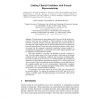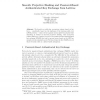458 search results - page 56 / 92 » Designing and executing protocols using the event calculus |
INFOCOM
1997
IEEE
14 years 1 months ago
1997
IEEE
In earlier work we have formulated a collusion problem that determines whether it is possible for a set of colluders to collectively discover a target set of information, starting...
OOPSLA
2007
Springer
14 years 3 months ago
2007
Springer
Omniscient debuggers make it possible to navigate backwards in time within a program execution trace, drastically improving the task of debugging complex applications. Still, they...
AIME
2003
Springer
14 years 2 months ago
2003
Springer
Abstract. Clinical protocols and guidelines have been used in the medical domain for some time now, primarily to reduce proneness to errors during the treatment of specific disease...
OOPSLA
2005
Springer
14 years 2 months ago
2005
Springer
A number of effective error detection tools have been built in recent years to check if a program conforms to certain design rules. An important class of design rules deals with s...
ASIACRYPT
2009
Springer
14 years 3 months ago
2009
Springer
Abstract. We describe a public-key encryption scheme based on lattices — specifically, based on the hardness of the learning with error (LWE) problem — that is secure against ...


